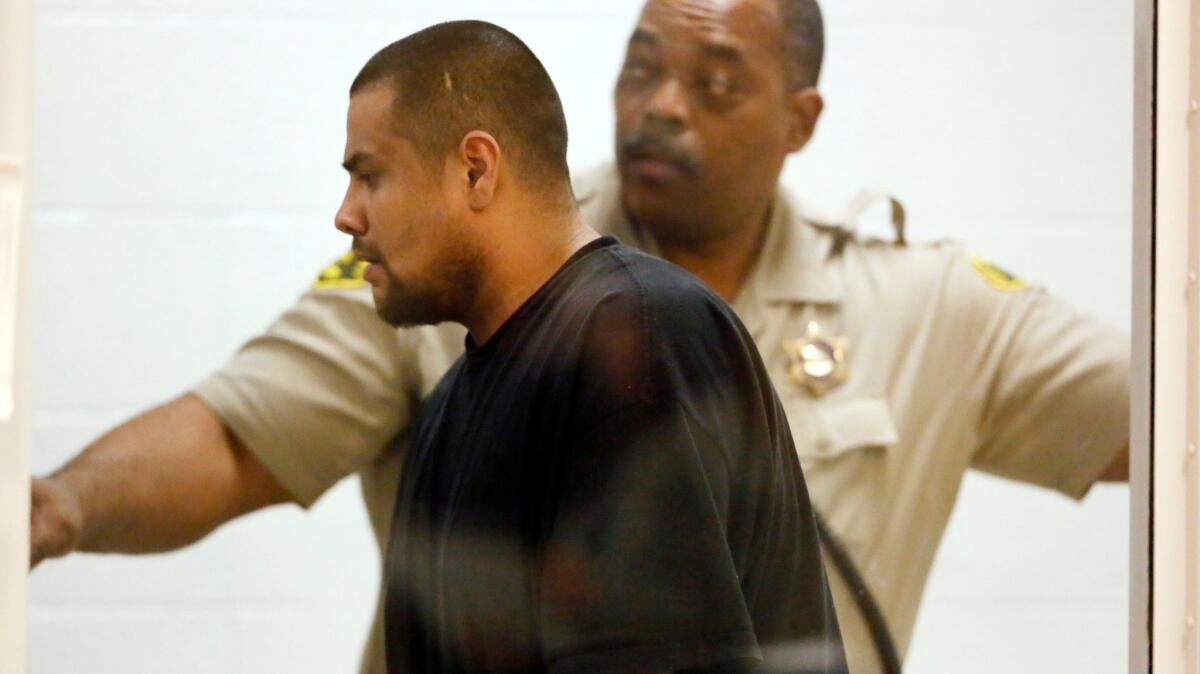L.A. sheriff’s deputies disciplined after horrific torture death of 8-year-old boy
- Share via
It was the worst case of child abuse that local officials had ever seen.
The death of 8-year-old Gabriel Fernandez became a grim symbol of the failure of Los Angeles County’s child welfare system, prompting criminal charges against four social workers and far-reaching reforms of how authorities oversee abused and neglected children. Gabriel’s mother and her boyfriend were charged with his murder.
But far less public scrutiny has been given to the role of L.A. County sheriff’s deputies who investigated Gabriel’s situation in the months before his 2013 death.
A Times review of grand jury testimony, child welfare records and recently filed court documents shows that deputies visited Gabriel’s home multiple times during the eight months prosecutors say he was being tortured and beaten. But the deputies found no signs of abuse and did not file paperwork that would have led specially trained detectives to do more investigating.
One deputy went to the boy’s Palmdale home after his teacher said he had been beaten with a belt. Another deputy, responding to a report that Gabriel was suicidal, left the home without examining or interviewing him.
When a security guard called to report that Gabriel had bruises on his face and what looked like cigarette burns all over his scalp, he was rebuffed by a sheriff’s deputy who screamed that a child being burned was not an emergency, according to court records. Another deputy who eventually went to check on the boy decided that the injuries were caused by a fall from a bicycle.
The department’s final investigation came a week before Gabriel’s death. A sheriff’s deputy tried to find him after school officials reported that he had been absent for a long period and might be a victim of abuse. Gabriel’s mother said that her son had moved to Texas, and the deputy soon halted the inquiry. In fact, Gabriel was still in Palmdale, being beaten with a bat, shot with a BB gun, starved, locked in a small box and forced to eat cat feces, according to prosecutors.
None of the nine deputies involved in Gabriel’s case have been criminally charged, and all still work for the Sheriff’s Department. But prosecutors said in court papers that some were disciplined internally.
The Sheriff’s Department declined to provide specifics, citing state laws preventing the disclosure of peace officer discipline. Through an attorney, each of the deputies declined to comment.
A county blue ribbon commission recommended a series of reforms in the wake of Gabriel’s death, including better training for law enforcement officers and better sharing of information with social workers. Six months after Gabriel’s death, the Sheriff’s Department began requiring deputies to file a one-page report for every child abuse call, regardless of whether they find evidence of a crime.
The case highlights a wider problem in the way patrol officers approach child abuse allegations, said Dan Scott, a retired sheriff’s sergeant and longtime child abuse investigator. Patrol cops often treat child abuse calls as a low priority, especially when social workers are already involved with the family, he said.
“Law enforcement treats these crimes like second-class crimes,” Scott said. “Cops believe it is a social worker’s job. They are looking for a reason to clear the case, and as a police officer, you have got to treat child abuse like any other crime.”
::

Isauro Aguirre in a Lancaster court after he was charged with murder in the 2013 death of his girlfriend’s 8-year-old son, Gabriel Fernandez. He has pleaded not guilty.
Gabriel Fernandez had lived with his maternal grandparents since he was a few months old, when his mother, Pearl Fernandez, who struggled with a drug problem, signed over legal guardianship in a notarized document.
In September 2012, when Gabriel was 8, Pearl decided she wanted him back.
Her parents, Robert and Sandra Fernandez, asked the Sheriff’s Department to mediate the custody dispute, telling Deputies Adam Hilzendeger and David Nisenoff that Pearl had a history of neglecting and physically abusing her children.
In grand jury testimony, Robert Fernandez said he showed the deputies a notarized guardianship document as well as school records indicating that he and his wife were authorized to act as Gabriel’s parents.
According to the Sheriff’s Department’s policy manual, the welfare of the child “is of paramount concern” in custody disputes. In “problematical situations” such as those where the documentation is in question, deputies should file a report to prompt a thorough investigation by detectives.
But the deputies who came to the Fernandez house did not file a report, according to a court motion filed earlier this year by the district attorney’s office. Instead, they sided with Gabriel’s mother, dismissing the documents his grandparents showed them.
“And he just said it was fraud. So he got into an argument with my wife,” Robert Fernandez said of one of the deputies in grand jury testimony.
Gabriel went to live with his mother and her boyfriend, Isauro Aguirre. The abuse, prosecutors say, started soon afterward.
After moving in with his mother, Gabriel enrolled in a new school, Summerwind Elementary.
His teacher, Jennifer Garcia, soon noticed that something was wrong with her new pupil, according to her testimony before the grand jury.
The day before Halloween, Gabriel confided in Garcia: His mother had hit him with the metal part of a belt, drawing blood.
Garcia testified that she called a child abuse hotline and spoke to Gabriel’s caseworker, Stefanie Rodriguez, one of the four social workers from the Department of Children and Family Services who were later charged in the boy’s death.
A sheriff’s deputy, Imelda Rizo, then went to Gabriel’s house and wrote an entry in her computer log: She had observed no injuries on Gabriel and saw no indications of child abuse, sheriff’s homicide Det. Timothy O’Quinn told the grand jury.
Since at least 2009, Sheriff’s Department policy has required that deputies “thoroughly investigate” every child abuse allegation. They should write a police report — which would trigger a follow-up investigation by detectives — unless they can articulate beyond a reasonable doubt that no child abuse occurred.
Rizo did not file a police report, according to the prosecution motion.
Rodriguez, the social worker, also looked into the alleged belt beating. The boy denied his earlier story, terming it a joke, she wrote in a report.
By early November 2012, it was obvious to Garcia that Gabriel’s home situation was getting worse.
She began lying on the weekly reports she sent home with Gabriel, drawing a smiley face instead of giving a true account of his behavior, out of fear that a bad report would cause his mother to hit him, she told grand jurors. Each time she saw a new instance of possible abuse, she notified a social worker.
On Jan. 29, 2013, Gabriel returned to school after a weeklong absence. His eyes were swollen, and there were bruised dots all over his face. At first, he told his teacher that he fell and hit his face while playing with his brother.
Later, he said that his mother had made him exercise as punishment and shot him in the face with a BB gun, Garcia testified. Garcia said she notified Rodriguez, the case worker. It is unclear whether the Sheriff’s Department was notified.
On Feb. 27, a counselor assigned to the family by DCFS called 911: Gabriel had written a suicide note.
The deputy who went to Gabriel’s house at 2 a.m. did not see Gabriel or speak to him, according to the district attorney’s motion. Aguirre told the deputy, Federico Gonzalez, that Gabriel was fine and that DCFS was involved with the family.
According to DCFS records, the deputy determined that Gabriel did not have a plan for how he would kill himself. He advised Gabriel’s mother to keep an eye on him and get mental health services for him.
Sometime in 2013, a sheriff’s detective, Vanessa Reddy, was assigned to investigate an allegation submitted to the county’s child abuse database that Gabriel had been sexually abused by an uncle, according to the motion by the prosecutor, Deputy Dist. Atty. Jonathan Hatami. Reddy interviewed Gabriel but did not appear to have interviewed the uncle, the motion said. She made an entry in her computer log but did not file a police report, the prosecutor wrote.
**
On April 26, Arturo Miranda Martinez, the security guard at the county employment office, called 911 to report that Gabriel was bruised and burned all over his face and head. Deputy Robin Soukup screamed at Martinez that a burned child was not an emergency, the prosecutor wrote in his motion.
At Gabriel’s home, Deputy Jonathon Livingston spoke to Aguirre, saw Gabriel and then wrote an entry in his computer log, according to court records. Gabriel had fallen off a bicycle, and there was no evidence of child abuse, the deputy wrote.
Livingston’s log entry made no mention of examining the child for physical injuries, O’Quinn, the homicide detective, told the grand jury. Like the other deputies who visited Gabriel’s home, Livingston did not file a police report that would have prompted further investigation.
In his motion seeking the Sheriff’s Department’s investigative records, the prosecutor slammed the deputies’ response.
“It is unclear why a child being burned all over his body is not an emergency,” Hatami wrote. “It is unclear why a police report was not filed and if the security guard was interviewed by Deputy Livingston.”
New deputies are trained in the Sheriff’s Academy to “be suspicious” and to square the family’s story with the injuries on the child, said Scott, the retired sheriff’s sergeant.
That training is carried over into the field, said Sgt. Marvin Jaramilla of the Special Victims Bureau.
“We conduct a thorough investigation. We do not take the parent’s statement at face value,” Jaramilla said.
The county blue ribbon commission saw room for improvement and recommended better training for law enforcement officers, including yearly refresher courses.
::
A few days after the encounter with the security guard, Gabriel returned to school.
In photos from a Mother’s Day project that were shown to the grand jury, his skin was peeling off his forehead, and he had a black eye in the healing stages, along with a bruise-like mark on his neck. One eye was completely bloodshot, prompting his classmates to say he looked evil, his teacher testified.
It is unclear whether the injuries were the same ones the security guard observed or whether the boy had suffered more abuse in the intervening days.
It is unclear why a child being burned all over his body is not an emergency.
— Deputy Dist. Atty. Jonathan Hatami
Garcia called a social worker to report the latest signs, noting that Gabriel’s story about falling off a dirt bike did not seem believable, according to her grand jury testimony.
“It didn’t seem to go along with the injuries that he had and that he looked really bad,” she recalled saying to the social worker.
In May, Gabriel was absent from school for several days. Worried school officials assigned Jason Lee Lasley, a sheriff’s deputy who worked at the school, to check on the boy and see if he was being abused.
Lasley tried and failed to find the boy’s house — he had the wrong address. He told the grand jury that when he spoke to Pearl Fernandez on the phone on May 16, she said the boy had moved to Texas to live with his grandmother. He tried to get a better address from Gabriel’s school, then appears to have ended his investigation. He did not write a police report, he testified.
On May 22, 2013, sheriff’s deputies responded to a call from Gabriel’s mother and found that the boy was not breathing. Pearl claimed he had fallen while playing with his siblings and that the bruises on his body were self-inflicted. She said the missing skin on his neck came from vigorous scrubbing with a washcloth.
The county medical examiner who performed Gabriel’s autopsy said to the grand jury that he had never seen so many skin injuries on a child. The boy’s skull was fractured, his ribs were fractured and he had BB pellets in his chest and pelvic region. A burn above his groin penetrated all the way through the skin into the soft tissue.
Back at Gabriel’s school, his teacher was hoping he had really moved to Texas. In her gut, she knew it wasn’t true, she told the grand jury.
When the principal called her into a meeting with a district official she had never met, she thought maybe she was in trouble.
As the principal opened his mouth to speak, his face turned white. She knew.
“Is it Gabriel?” she asked.
MORE ON GABRIEL FERNANDEZ
Head of L.A. County’s child protective services agency to retire in early 2017
Social workers arraigned in case of tortured, fatally beaten 8-year-old boy
More to Read
Sign up for Essential California
The most important California stories and recommendations in your inbox every morning.
You may occasionally receive promotional content from the Los Angeles Times.












